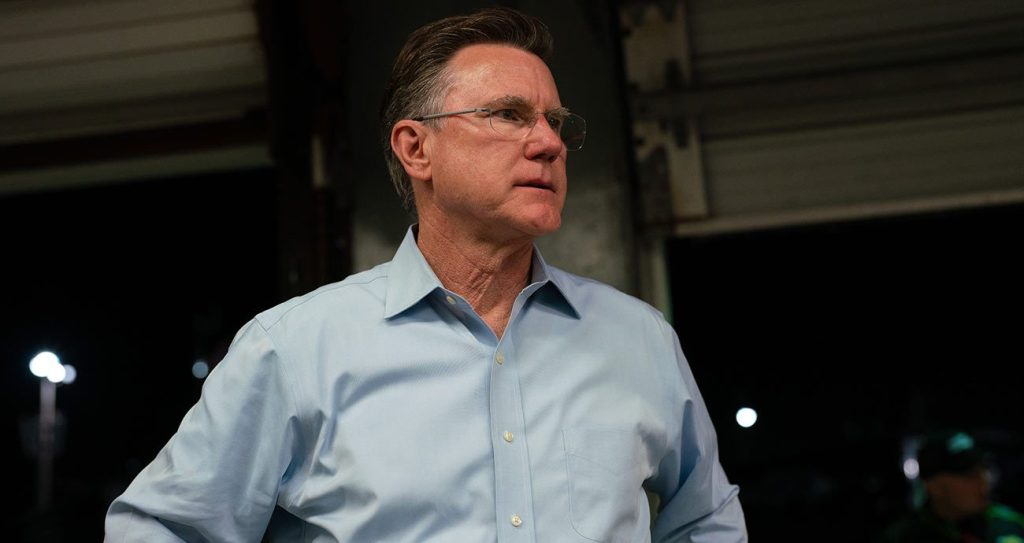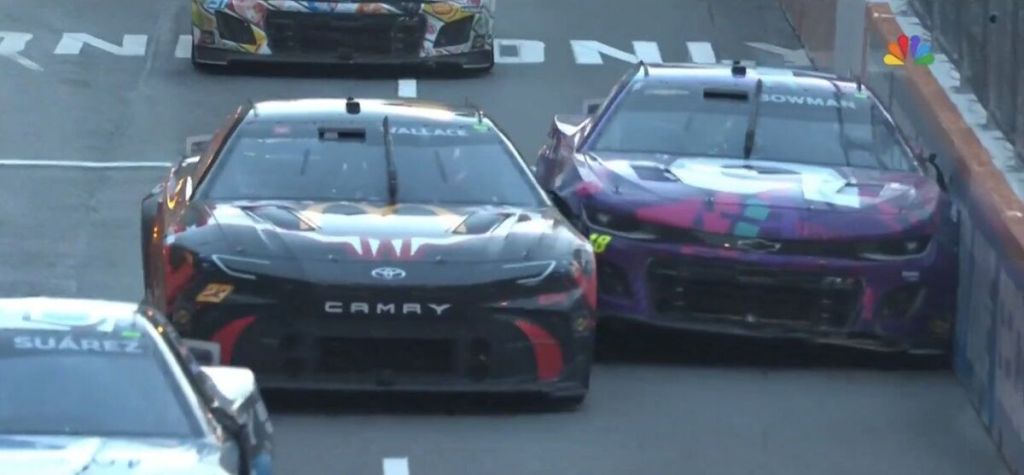
Actions detrimental is all the rage in NASCAR right now and not Denny Hamlin’s podcast of the same name.
This is about the subset of sections to the NASCAR rule book that oversees behavior penalties for issues like intentional crashing and fighting, topics that continue to come up this summer, leading both the industry and fans to ponder the application of consistency throughout each instance.
For example, at Nashville Superspeedway, Layne Riggs was parked two laps for a retaliatory shot to the back bumper under caution against Stefan Parsons. Two days later, Carson Hocevar did not receive any real-time penalty for intentionally right rear hooking Harrison Burton under caution but did receive a $50,000 fine later in the week.
That’s the same fine Bubba Wallace received after the race weekend in Downtown Chicago for a hard door slam that squeezed Alex Bowman into the wall after the checkered flag. At the same time this was happening, Chase Elliott took a considerably lighter swipe at Daniel Suarez and received nothing more than a talking to by league officials.
A talking to is exactly what Corey Lajoie is going to receive before the race weekend at Indianapolis Motor Speedway for his part in contributing to an incident in which Kyle Busch spun off his bumper and collected several other drivers before hitting the wall.
Some have drawn parallels to the right rear hooks into the wall that led to a suspension last year for Chase Elliott (against Denny Hamlin in the Coca-Cola 600) and Bubba Wallace in 2022 (against Kyle Larson) at Las Vegas.
But then, if what Wallace did to Bowman was so egregious, why wasn’t Ty Gibbs fined more than $15,000 for taking a door swipe at Sam Mayer at pit road in 2022 at Martinsville in the Xfinity Series. Even if you escalate that to Cup Series rates, maybe that’s $30,000 at most for something that was potentially more harmful to more people than what Wallace did.
This doesn’t even begin to make sense of the $75,000 penalty to Ricky Stenhouse Jr. for throwing the first punch at Kyle Busch after the All-Star Race, mostly under the pretense that he had two hours to think about it.
“I’m not even going to pretend to what they’re thinking,” Stenhouse said when asked about the various penalties and consistency questions over the weekend at Pocono Raceway.
And there were many, too.
Bowman has consistently said that he did not want to see NASCAR issue a penalty to Wallace, because he believes the retaliation was deserved. Of course, that is something Bowman can afford to feel after winning the Chicago Street Race, and he is perhaps being nice.
But then Suarez said if Wallace was penalized for what he did to Bowman, than it’s worth having the conversation about Elliott being subject to a penalty based purely on intent. Suarez said the contact was only lighter than Wallace, Bowman because he was driving more defensively.
“It’s a delicate situation because what happens if I wasn’t paying attention and I did get hit? Was he going to get fined. I’m good because I was paying attention and didn’t get hit so he’s not getting a fine. That’s a little bit tricky.
“I think it’s a very big penalty, $50,000 for hitting somebody. I’m not saying Chase should have been fined. He shouldn’t have but it’s a big fine. A lot of people have done similar things this year. (Martin Truex Jr.) did it at Richmond. If that’s going to be a fine, it has to be consistent and NASCAR is trying its best to be consistent but we’re not there yet.”
Truex?
After getting jumped on the final restart by Hamlin, he door slammed Kyle Larson after the checkered flag at Richmond, mostly because he was frustrated to be racing for third and not the win, and then drove into the back of his teammate’s car to show frustration to him too.
Truex targeted multiple drivers in that race and received no penalties afterwards.
The difference, according to NASCAR vice president of competition Elton Sawyer during a media availability on Tuesday is the severity of contact.

“If you just back up to Chicago, (Elliott) and (Suarez) versus (Wallace and Bowman), two completely different scenarios,” Sawyer said. “You’ve got one, where (Elliott) … and we did have a conversation with him … but both scenarios are different because Chase kind of accelerates to catch (Suarez) and we’ve seen that for many years, drivers showing displeasure after the race is over, very slight contact …
“That rises to the level where we don’t want to be in the middle of any of that. That’s how we we reached the decision on that.”
Wallace was different, Sawyer said because of how heavy the impact was, an because the window net was down and seat belts loosened.
“The right front tire comes off the ground on the 48 and the left side hits the wall,” Sawyer said. “Window nets are down. If you look at the in-car camera, seat belts loose on the 48 car. They’re completely different.
“That situation rose to a level where we couldn’t allow that to continue the way (Wallace) reacted to (Bowman).”

So that precedence tracks with Truex at Richmond too, even if he wanted to voice that displeasure to two drivers, because tires were not lifted off the ground and certainly no one was squeezed into a wall.
But Elliott also felt like that was reaching too far too.
“I don’t think he should have been fined,” Elliott said. “I understand. I get it. But you’re getting in the weeds with some of that stuff. Nobody was hurt. It was unfortunate I guess just the circumstances but I didn’t see it to be a huge deal.”
In the case of Lajoie and Stenhouse, Sawyer said SMT data and radio transmission was all evaluated and they found nothing that rose to a level beyond hard racing.
“Back up to this past weekend, we are in race, in competition, two guys racing hard,” Sawyer said. “If you listen to the in-car audio (from Lajoie), we didn’t hear anything from the driver. I know there were comments from the crew chief or spotter but neither one of them are driving the car. I’ve had those guys in my ear before. They’re not driving.
“We plan to have a conversation with Corey to make sure he’s in a good place there but yeah, that one, in race we let the guys race.”
Sawyer said it’s different had there been an intentional hook left to the right rear but they didn’t see anything beyond Lajoie refusing to lift.
“No penalty on the 7,” he said. “If you go back, you start catching guys in the right rear, weve shown we will respond to that.”
All fair.
The one thing Sawyer does not find fair, at least accurate, is the perception that NASCAR is issuing penalties based on how social media reactions filter in on the days after a potential infraction. There was a consensus that Stenhouse was fined so heavily because it came during the All-Star Race and received mainstream attention.
Hamlin suggested that Wallace was only fined because of the attention his ordeal warranted, since it was captured in real-time on the broadcast, where Elliott and Suarez was not.
“It’s a judgment call,” Hamlin said. “More than likely, we’ve seen these things happen in other sports where the camera’s on you live, not a cutaway where you’d say ‘oh, by the way, this happened after the checkered,’ I think it being live and everyone seeing it, probably caused a little more of a social media uproar which then they responded to that.”
When Cup Series managing director Brad Moran said the in-car videos that tricked out after the race ‘got our attention’ was not in reference to the temperature of the fan base, but rather a snapshot of the content the review every week, regardless.
“That’s not what he meant and I know what he meant because we talked about it,” Sawyer said. “He meant, it got our attention to focus on it, which we always do.”
Lastly, when it comes to consistency, Sawyer says they do but fans often do not consider how multiple strikes factor into a decision and that was best illustrated by the decision to park Riggs for two laps at Nashville.
“Go back to Nashville, I explained to Layne Riggs why he was held two laps,” Sawyer said. “In the tower, I mentioned to Seth Kramlich, the series director, ‘you need to talk to Layne and Stefan,’ and he said he’s already talked to Layne.
“So, I said, next step is hold him for two laps, and the next step is what happened to Carson is to dig into his pocketbook.
“We review these. We would prefer to wait and get all the data, all the footage and audio so we’re making the right decision. That’s not to say in Cup we wouldn’t hold someone for multiple laps but normally we try to, and as we’ve done in the past going back to William and Denny two years ago at Texas or Larson and Bubba at Vegas, the consistency part, I can go on and on about how we have been consistent.
“The end result, fans may look at it and we love our fans and their viewpoints, but from an officiating standpoint, our goal is to be fair, but again, every situation is a little bit different.”
Matt Weaver is a Motorsports Insider for Sportsnaut. Follow him on Twitter.


